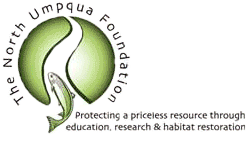This is paper from one of our scholarship recipients Wilhem Dieh:
I. PROPOSAL TITLE:
Assessment of Salmonid Habitat Improvements Associated With Large Wood and Boulder Weir Placement in Wolf Creek
II. GOALS & OBJECTIVES:
• Study substrate makeup prior to and following restoration to assess the geomorphic responses to habitat structure placement in Wolf Creek.
• Assess the links between responses derived from restoration and salmonid habitat abundance.
• Model geomorphic processes in the Wolf Creek watershed using existing data to simulate future substrate dynamics. Use the model to assess trajectories of salmonid habitat abundance under current substrate regime, as well as habitat abundance in scenarios of increased gravel augmentation.
III. PROJECT SUMMARY:
Stream monitoring and life cycle monitoring data suggest that Wolf Creek is one of the most productive streams for Oregon Coast Coho Salmon in the Upper Umpqua watershed. The BLM, along with several other partners, have invested $1,600,000 in restoration efforts in Wolf Creek, constructing boulder weirs, adding spawning gravel and large wood intended to increase the spawning capacity of Wolf Creek. A desired outcome of restoration in this watershed was to shift the current substrate regime from a high discharge, low sediment accumulation watershed to a watershed with lower discharge during peak events and greater capacity to retain spawning gravel.
To date, the BLM has conducted long term spawning and snorkel surveys in the basin, but a thorough assessment of available stream data collected by the Aquatic and Riparian Effectiveness Monitoring Project has not yet occurred. Having surveyed 33 sites on four visits between 2006 and 2022, AREMP has invested close to $170,000 for monitoring in Wolf Creek and has thus far only used data gathered there for routine, region wide five-year monitoring reports. AREMP takes a wide range of stream habitat data, from substrate size to pool frequency to large wood abundance, all of which can be used for this research. The wealth of data collected by AREMP in this watershed creates a unique opportunity answer important research questions without the need for additional data gathering or restoration implementation.
This project would be carried out by Wilhem Diehl, a M.S. student in the Fisheries and Wildlife program attending Oregon State University from 2023-2025. Wilhem Diehl has worked for AREMP for three seasons as a crew leader and spent four weeks total in the Wolf Creek watershed collecting habitat data. His knowledge of the data set and the study area are unique assets that should be leveraged towards this project. Dr. Melanie Davis will serve as the chair of Wilhem’s graduate advisory committee, and be able to leverage her own wealth of experience in freshwater science and the USGS cooperative unit’s resources towards this project.
The masters thesis project will focus on substrate data collected by the Aquatic and Riparian Effectiveness Monitoring Plan at 33 sites in Wolf Creek. The evaluation of this data will help to answer research questions concerning efficacy, site changes associated with salmonid abundance, and evaluation of the short and long term effects on substrate conditions. The data for this project has been fully collected and will not require any additional data gathering. The dataset in question surveys seven control sites, ten treatment sites, twelve reference sites, and five headwater sites. All sites were visited in 2006, 2011 and 2022, and 20 sites were visited in 2015. AREMP collects a wide array of data on in-stream conditions at every survey site, but for the purposes of this project, their compilation of data on substrate will primarily be of use.
IV. CONTACTS:
Wilhem Diehl – Candidate for MS in Fisheries Science at Oregon State University
1524 NW 11th St. Corvallis, OR
diehlwi@oregonstate.edu
207-478-5503
Melanie Davis – Assistant Unit Leader – Cooperative Fish and Wildlife Research Unit
104 Nash Hall Oregon State University Corvallis, Oregon 97331
melanie.davis@oregonstate.edu

